Nokia Lumia 930 Review
by Brett Howse on September 8, 2014 3:00 PM EST- Posted in
- Smartphones
- Microsoft
- Nokia
- Mobile
- windows phone
- Lumia
Camera
Nokia has made a name for itself with its focus on mobile camera architecture. With the release of the PureView 808, it stamped its authority on the camera phone market, and with the launch of the Lumia 920, it moved the PureView branding to less obtrusive cameras. The Lumia 930 has one of the best smartphone cameras, at least on paper. The Lumia 930 ups the ante compared to the Lumia 920, 925, and 928 of last year, with a 1/2.5” 20 megapixel sensor which results in a pixel size of 1.1 microns. In front of the BSI CMOS is a 6 element Zeiss lens which gives an F/2.4 aperature, and the camera features optical image stabilization and a dual LED flash. Unlike the Lumia 1020, the much smaller sensor size allows for no camera bulge at all.
One thing that Brian Klug focused in on with the original HTC One review was the importance of pixel size. At 1.1 microns, the pixels in the 930 are much smaller than the HTC One’s 2.0 micron pixels, and even much smaller than something like the iPhone 5s with its 1.5 micron pixels. For a given sensor size, larger pixels are going to increase low light performance at the tradeoff of spatial resolution. The other option is one that we are starting to see on some phones, but no one has taken it to the same place as Nokia has. That option is sensor size. Larger sensors allow for much more light to be gathered, mitigating the poor results of smaller pixels. Nokia uses pixel binning in its high resolution smartphone cameras to improve the low light performance by using multiple pixels to give the end result, and displays it as a 5 megapixel image. The original image in its full resolution is also available on the device as well as your OneDrive camera roll if set to upload photos. With the Lumia 1020, this was taken to an extreme with a massive 1/1.5” sensor, which is why that phone requires a hump on it for the camera. By using a somewhat smaller sensor on the 930, they still allow some pixel binning, as well as a larger sensor than most other smartphones.
To show the differences in camera sensor sizes, I have created a graphic which shows the relative size of several camera sensors.
APS-C (grey), Lumia 1020 (green), Panasonic DMC-FZ28 (red), Lumia 930 (blue), iPhone 5s (white), Lumia 630 (orange) Rear Camera sensor sizes (relative)
The grey box is APS-C which is the sensor used in DSLR cameras from some companies such as Canon. As you can see, the sensor absolutely dwarfs all of the other sensors. This is one of the main reasons a DSLR is such a good camera compared to point and shoot cameras. Higher end DSLR cameras offer even larger sensors, with a higher price tag to match. The red box is a 1/2.3” sensor which is a common sensor in point and shoot cameras. The Lumia 1020 is the green box, and it becomes pretty apparent just how massive this sensor is compared to all other smartphone cameras. The PureView 808 had an even larger sensor, but it lacked back-side illumination. The blue box is the Lumia 930 sensor size, which is shared with the Lumia 1520. At 1/2.5”, it is only slightly smaller than a point and shoot camera. The white box is the Apple iPhone 5s, which is well known for being one of the better smartphone cameras out there. The final orange box is the Lumia 630, with its 1/4” sensor. It becomes very clear why that phone struggled so much in the low light tests during our review.
Due to the common perception that the smartphone is killing off the point and shoot market, I thought it would be interesting to compare the Lumia 930 not only with other smartphones, but also a Panasonic DMC-FZ28 point and shoot, as well as a Canon EOS Rebel T4i DSLR just to see how far we have come with smartphone camera technology.
Before that, we can take a look at the ISO 12233 test chart, and specifically look at the sagittal and tangential lines to see how well the sensor can capture fine detail.
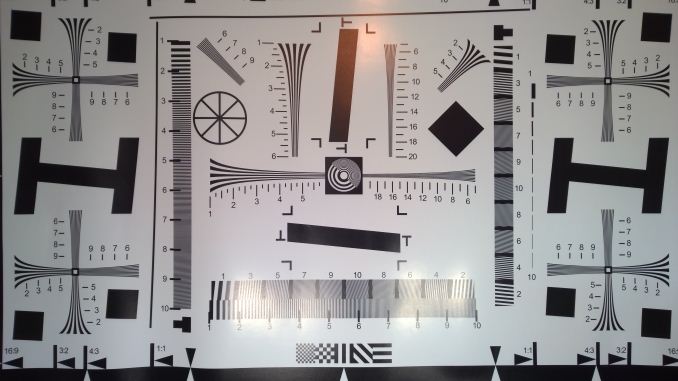 ISO 12233 Test Chart captured by Nokia Lumia 930
ISO 12233 Test Chart captured by Nokia Lumia 930
With a 20 MP sensor, the Lumia 930 can resolve detail fairly well, but compared to the Lumia 1020 there is a lot more aliasing in the picture. It is a good result, but certainly nowhere near the capabilities of the 1020.
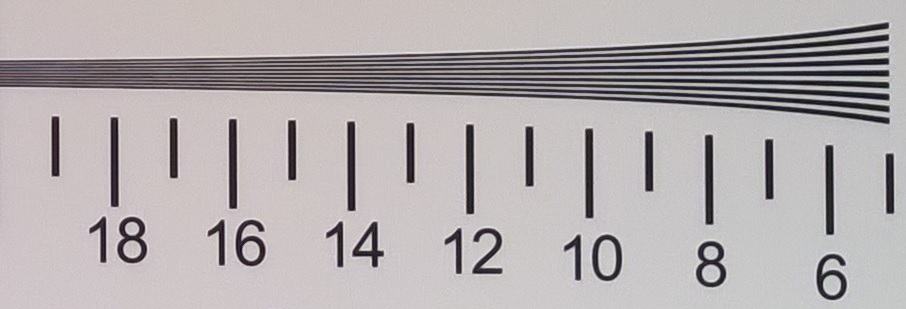
Taking a look at the sagittal crop, we can see the Lumia 930 starting to fall off around the 15 mark, where as the 1020 resolves very well all the way past 19. Compared to the iPhone 5s though, it certainly wins as the iPhone starts to drop off around the 13 mark. The LG G3 performs very well here, with good results all the way up to 16.
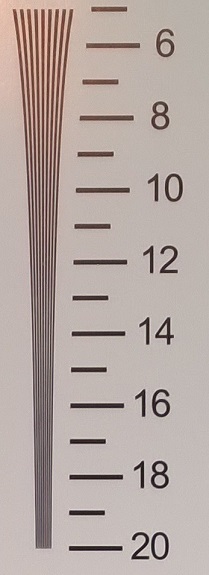
The tangential crop is a similar situation, with the Lumia 930 starting to fall off around the 15 to 16 mark, with the Lumia 1020 doing well all the way to 20. The iPhone 5s once again starts to fall off around the 13 mark, and the LG G3 falls off around the 14 mark in this crop.
Lab Scenes
We turn to our lab scenes once again to see how the 930 can shoot in a controlled environment on a tripod, with fixed lighting. For the bright scenes, we are over 1000 lux on the test target. These tests were performed with the Lumia 930, Lumia 1020, Panasonic DMC-FZ28, and Canon T4i. The default mode for pictures on the 930 is 16x9, so that was used.
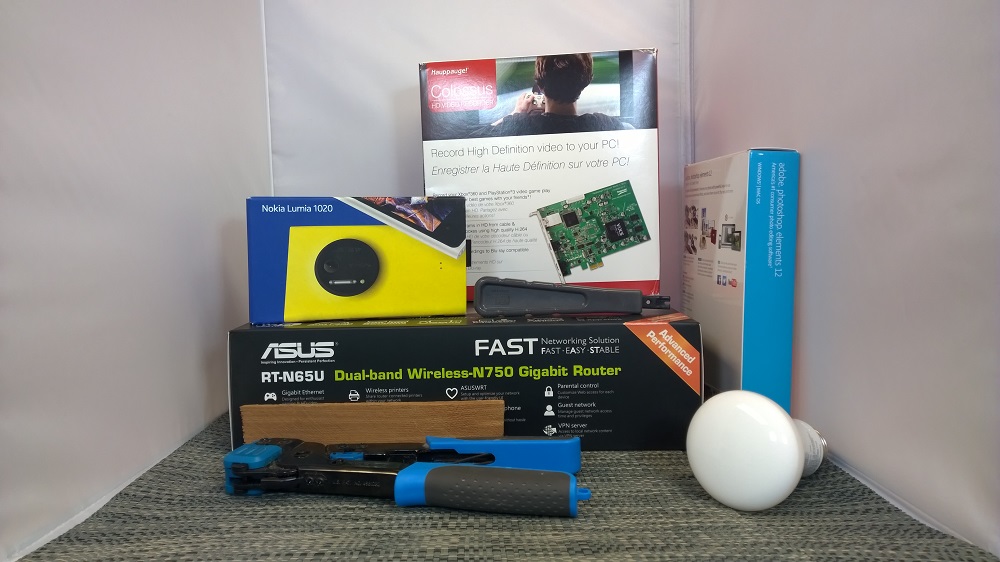
Here all the cameras do well, with the exception of the Lumia 1020, which struggles on lighting and gives the image a green cast. All of the other images though are excellent.
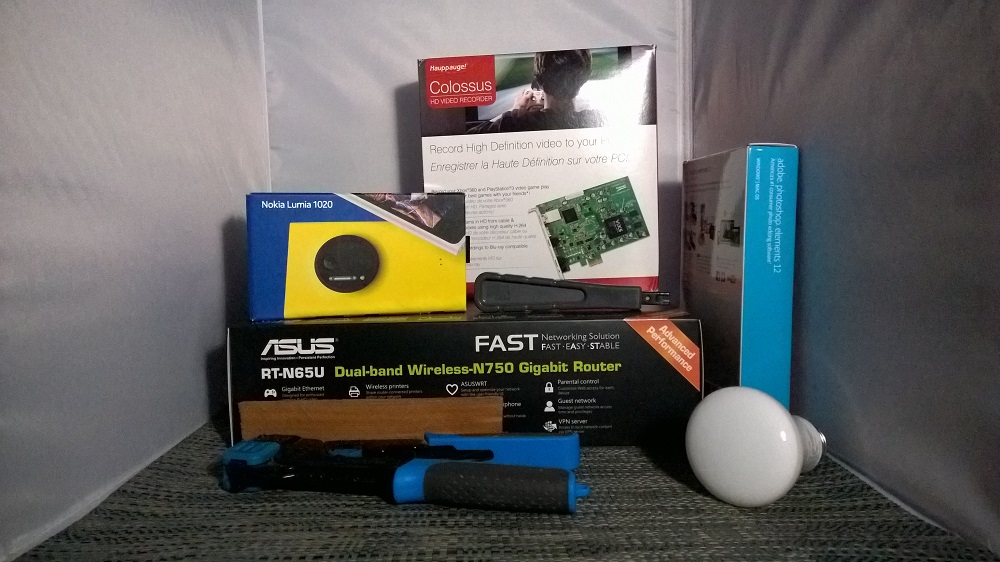
Moving down to 5 lux, the situation changes quite a bit. The T4i, with an APS-C sensor, easily captures the most light and the result is a photo that almost defies how dim the scene is. The next best image is the Lumia 1020, which once again does not get the white balance 100%, but the amount of noise is certainly lower than the remaining two. The 930 seems to do very well on white balance, and outperforms the Panasonic camera in this test.
Outdoor Scenes (Night)
We always want to test not only in the lab, but also in real world conditions. We took our four cameras out at night to do a couple of photographs. The first scene is a park bench, lit by a low-pressure sodium-vapor street lamp. The sodium light gives the distinctive yellow light we are all used to, and is a real test to any camera to get the correct white balance and color for the scene.
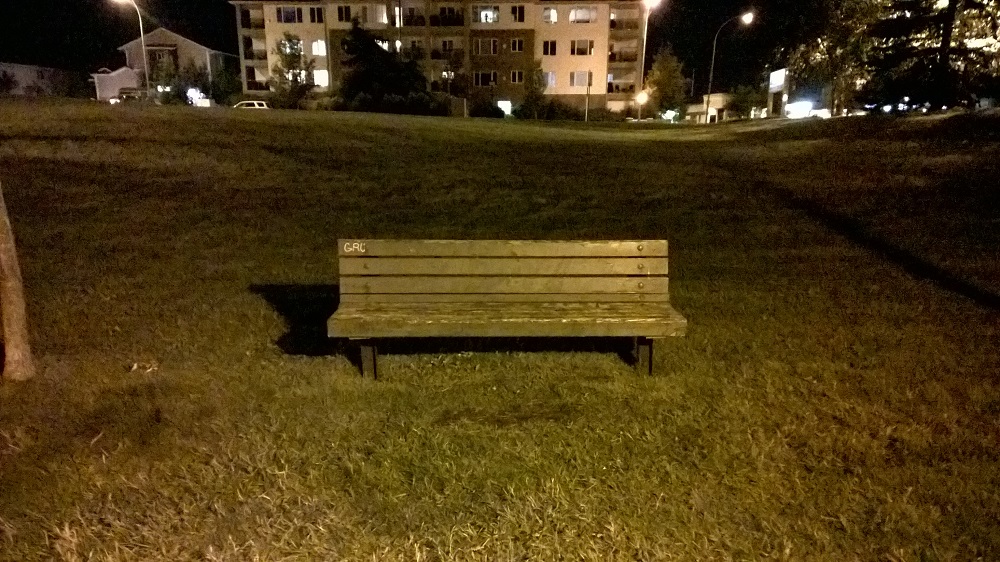
With the lab scenes, the images have to be studied quite a bit in order to make out the minute differences of each camera, but that is not the case with this test. One quick note about the results though. All of the cameras were tested in full-auto mode, however the Panasonic struggled in auto and resulted in an almost completely black scene. Moving to a “night scene” mode change the shutter speed to 8 seconds, which is unusable without a tripod. Eventually I found a “candle lit” mode which at least allowed a photo to be taken. Even with this benefit, the Panasonic came in last, and by quite a bit. To achieve even this result, the Panasonic had to use a 1 second shutter speed, and although it also has OIS, it is still difficult to hold a camera still enough for that kind of shutter speed. It also completely failed on the scene color, with a very red result. The DSLR on the other hand had no issue with focus and used ISO 6400 and 1/3 seconds to take this picture which is easily the sharpest and clearest picture of the set. However the DSLR got the color of the scene very wrong, and ended up almost bright yellow. This was full auto though, so any capable photographer would be able to fix this with manual settings, and also the DSLR can take pictures of a dark scene like this pretty much as fast as your finger can hit the shutter button.
Moving on to the smartphones, the Lumia 930 did a great job with the result. The picture has some noise to it, but overall the result is pretty good. The white balance is a bit off though, with the 930 trying to portray the scene as if it was lit by a white lamp, which it was not. The 930 used ISO-3200 and a 1/3 second shutter speed. The winner of this particular test is the Lumia 1020, which has a picture that is very sharp, has little noise, and was the best at getting the balance of the shot correct. Where the DSLR blew out the colors, the Lumia 1020 got them almost perfect.

Moving on to the next shot, it is the side of a grocery store which has some ambient light from the street as well as lettering on the building which has its own lighting. Unlike the last scene, the winner this time was the Canon DSLR, which got the white balance right and resulted in a clear shot without a lot of noise. The Lumia 1020 came in second in this test, as it once again got the white balance a bit green. The shot is fantastic though with little noise. The Lumia 930 did a great job here as well, with a much better white balance than the 1020, and a fairly clear result. The distant fourth place goes to the Panasonic DMC-FZ28, which once again had to be used in “candle light” mode, and the result is still far less than ideal. The scene is very dark.
Outdoor Scenes (Daylight)
Daylight scenes are much easier for all cameras due to the massive amounts of ambient light available. I took all four cameras to Wascana Park on a nice afternoon to get some pictures. Here all of the cameras did a pretty good job. The Lumia 930 got the color balance off on a couple of the scenes, but it was not to the point where the photo was unusable.

Here we can see the Lumia 930 shifted the color a bit to the red side, but all of the pictures are very good.
Looking at a crop of one set of images, we can see that all four cameras do well in this lighting.
 Lumia 930 (left) Lumia 1020 (left center) Panasonic DMC-FZ28 (right center) Canon T4i (right)
Lumia 930 (left) Lumia 1020 (left center) Panasonic DMC-FZ28 (right center) Canon T4i (right)
The smartphone bar has not been moved yet. The Lumia 1020 still wins this comparison, which considering the sensor size advantage is not that surprising. However what is amazing is how the Panasonic point and shoot, which was a well-regarded camera when it came out a few years ago, is so handily beaten by the Lumia 930. We have all known the point and shoot market is declining due to the popularity of smart phones, with a smart phone camera ordinarily being good enough for most occasions, however it is pretty clear that it is more than good enough if executed well. For all of the power of the Lumia 930, there is no camera bump at all required on this phone. In low light or dim light, there is a bit too much noise in the resultant images for my liking, but my benchmark is the 1020.
One other option on the Nokia PureView equipped phones is the ability to capture RAW image data, rather than just jpeg images. The default mode is to capture a 5 MP jpeg plus a high res jpeg (15-18 MP depending on if you are 4:3 or 16:9) but optionally you can save no high res image, or the high res image can be in the DNG format. This is not new to the PureView Lumias, but as this is the first review of one it is worth mentioning.
Capture Latency
I was impressed with the camera speed of the Lumia 630 when I reviewed it, but the Lumia 930 has a much larger sensor in terms of data per shot. Unlike the Lumia 1020 with its 41 megapixel monster, the 930’s relatively tame 20 megapixel camera falls into the supported size for the Snapdragon 800 SoC which can handle up to a 21 megapixel sensor. The Lumia 1020 required custom silicon to handle the sensor, which resulted in a very slow photo capture process. With the Lumia 930, I was hoping for something a bit quicker.
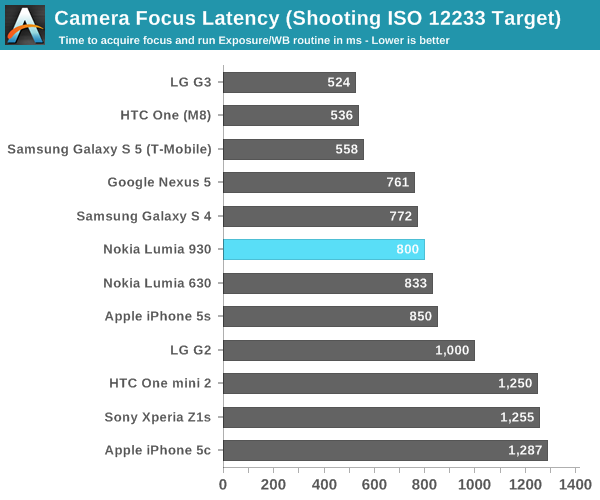
Focus latency for the 930 is very similar to the Lumia 630. It appears to be completely software limited, as both devices score almost the same. Focus latency for the 930 is quite a bit less than some of the Android phones available now, which have put an emphasis on this in recent devices.
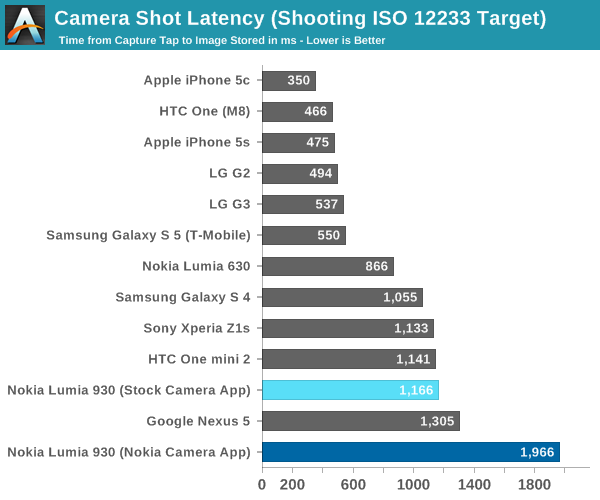
The shot latency is quite high for this device using the Nokia Camera, with a latency of almost two seconds. This is quite a bit higher than the stock camera app, which can take a photo in just under a second. It is possible this has something to do with the device saving two copies of the photo while in the Nokia Camera app, but setting it to only save a single image did not seem to affect shot time meaning the processing may be taking place anyway.
We add up the previous two results to get the total camera latency per picture.

The stock camera app total is not a fantastic result, but the Nokia Camera app is the worst result we have in this test. At IFA 2014, Microsoft announced that with the Lumia Denim firmware update, they will launch a new version of Lumia Camera which will address the shot to shot times dramatically – with them claiming being able to take photos just milliseconds apart. After these results, the update can not come quick enough.
Video
The Lumia 930 offers several choices in frame rate and resolution when recording video, with 1080p and 720p options as well as 30, 25, and 24 frames per second. What is missing is 60 and 120 frames per second, which is disappointing. It does however offer Dolby Digital 5.1 surround audio recording thanks to the four HAAC microphones. Nokia claims the HAAC microphones can record all the way up to 140 dB without clipping, which is a volume I am not able to get to for testing. There are also options for an Audio bass filter of 100 Hz, 200 Hz, or off, which would let you filter out things like engine noise if you needed to.
The resultant mp4 file, even with Dolby Digital enabled, will still have a 2 channel stereo track as well for compatibility.
With optical image stabilization, the Lumia 930 does a great job with video recording while on the move. This would be a fantastic video camera if it flushed out the missing features such as higher frame rate recording, as well as 4k video. The SoC supports all of this, so it is too bad it is not implemented.









































































115 Comments
View All Comments
Arbie - Monday, September 8, 2014 - link
SD police here...So my low-end Nokia 520 has microSD, which lets me easily swap in TV series that I watch when traveling or to kill time waiting somewhere. A new 930 at much higher price won't let me do that.
Hmmm... my love affair with Nokia (the 520 is great) will be coming to an end.
Windows Phone doesn't even have the flimsy excuses of the Android camp for no SD. It can even be read-only dumb storage, with no security issues. But no.
Not interested / will never buy it.
tuxRoller - Monday, September 8, 2014 - link
The Android issues aren't with security but, from what a Dev claimed (falsely, IMO) poor user experience.NikAwesome - Tuesday, September 9, 2014 - link
SD, mSD or whatever external storage are at least an order of magnitude slower than eMMC or ONFI or more advanced NAND interfaces. When an application like the Photo Gallery browser has to read lots of pictures from SD it is really a torture (several seconds, or tens of seconds). In the first eras of tablets and smartphones, people get accustomed that all has to launch in less than second (give or take), faster than their desktop application launch at home/work. So in this context, several seconds is inappropiately interpreted as sluggish CPU performance when the real bottleneck is in the storage IOs. These delays severely impact usability if you are used to full internal flash storage, where everything opens in under a second.I am not against mSD cards, I have an 8GB S4 mini and 32 GB mSD. I can easily tell the performance difference, but I have no choice if I want to take lots of pictures or film lost of 1080p videos.
Summing up, performance is the real reason why Google do not allow external storage on their devices (Nexus smartphones and tablets). From Apple point of view is arguable that they had contracts with music label records inheriting the iPod policy: "easy to load music into the device, a pain in the ass to extract it in order to make piracy more difficult"
jimbo2779 - Tuesday, September 9, 2014 - link
If you think sd cards make viewing photos on a phone a chore them it could be your phone or its support of SD cards that is at fault on the Lumia 620 there is no noticeable difference between photos on the phone memory and in SD card.Also there seems to be very little difference, if any, between the 620with all pics on SD and a925 with no SD support so speed is not a reason.
tobi1449 - Tuesday, September 9, 2014 - link
Plus: What's worse, photos that take a little bit longer to load or photos that either don't load at all because you don't have them with you or take much much longer and half of your free data?marcokatz - Friday, September 26, 2014 - link
Well Nokia sure is trying, but Microsoft is not exactly helping them out (they even released their own app for iPhone first... gosh). Anyway, as of today it's much better to go for one of the really good Android phones. /Marco from http://www.consumertop.com/best-phone-guide/tuxRoller - Tuesday, September 9, 2014 - link
That wasn't the reason given, iirc. The problem he mentioned was one of user removes sdcard, doesn't see his photos/apps on phone and gets confused. The other issue was technical, but, again iirc, was fixable if they wanted.jimbo2779 - Tuesday, September 9, 2014 - link
While that is the one technical issue with SD card implementation I would say there is a very small amount of people that would be able / willing to switch out the SD card and not be aware that they would be missing the contents of that SD card when they go into their photos app.When you remove a DVD from your computer do you wonder why you can't watch your favourite film anymore? Would anyone?
I am sure it has happened to someone at some point but realistically how many people would that affect compared to the amount of people that would put an extra 32 or 64 Gb in their phone and just be happy to have doubled or tripled their storage to keep a years worth of photos and videos of their kids on their phone.
Either way you look at it having the option to massively extend the amount of internal storage to have more media / apps in your phone is more favourable to most compared to having to resort to the cloud (which is just a no-go for a good portion of smartphone users across the world) or constantly removing stuff to make the newest stuff fit.
I would miss Glance but without SD card I will not be buying this which is a shame I was looking forward to it, don't even get me started on how the rumours for the 830 got me all excited and left me disappointed when the phone was finally announced. Either the 830 or 930 could have been WP halo phones for a lot of potential detractors to the WP platform, instead they are just a few tweaks short of stacking up very favourably with their android competition.
tuxRoller - Tuesday, September 9, 2014 - link
The technical issue was actually brought up by the poster below me (pjcamp). It was regarding creating a unified storage space across multiple devices.To be clear, I am NOT saying these were good reasons, I only brought them up in response to the parent who I thought MIGHT have been claiming that the reasons android dropped sd card support was related to security.
I really wish that sdcards (or some other removable storage standard) made a comeback on android.
Rama TT - Saturday, September 13, 2014 - link
"""Summing up, performance is the real reason why Google do not allow external storage on their devices "" Yeah right and it has nothing to do with Google Drive